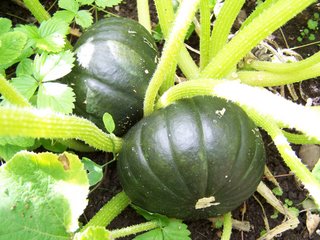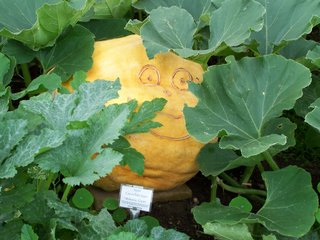Cucurbits
Cucurbits – cucumbers, marrows, courgettes, watermelon, squashes, pumpkins, gourds – and loofas.
(Below: a cosy family of 'Gold Bush' courgettes/marrows)

A confusing variety of shapes and sizes, but vegetables with personality. The Cucurbitacea family is a plant group which usually trails or climbs, and has alternate leaves which are usually heart or kidney-shaped, or fingered like a hand. They are all more-or-less tender annuals. So what’s the difference?
Most people realise that courgettes are really immature marrows, selected to be most tasty when young. But courgettes can also be yellow or even round! (See 'Rondo di Nizza', August 29 blog post). Marrows and courgettes are varieties of Cucurbita pepo, originally from North America, which also includes some pumpkins and summer squashes such as pattypan, which are also eaten immature. Courgettes and marrows tend to be bushy plants, not trailing too far. Courgettes can be ready in 8 weeks from planting in a good summer. Courgettes and summer squashes are usually eaten fresh, as their thin skins mean they don’t keep for long. Some can be used raw in salads.
(Below: acorn squash 'Zapallito de Tronco')

Marrows, acorn squash and spaghetti squash are sometimes described as autumn squashes and are picked when fully ripe. They can be kept for a short while, but have thin skins and should be eaten within weeks.
Cucurbita maxima, from South America, is the origin of many pumpkins, especially the really enormous ones such as ‘Atlantic Giant’.
(Below: 'Atlantic Giant' in early September and early October - it's even bigger now!)


C. maxima also accounts for winter squashes, which ripen during the autumn, such as Turks Turban.
(Below: a Turk's turban-type squash)

Pumpkins need a long, warm season to mature, up to 5 months, and can make enormously long plants. They have tough waxy skins, can be stored for months or even years, and usually need cooking before eating. They continue ripening when detached from the plant, in warm weather.
Still confused? See Kew Garden's great website for more info, and the Vegetable Expert will sort out any lingering confusion.
(Below: 'Uchiki Kuri', a winter squash)

It doesn’t stop there: the Butternut Squash, which is the only squash to be found frequently in British Supermarkets, is a variety of Cucurbita moschata. It was probably the first one to be cultivated, and there is archaeological evidence dating back to Mexico and Peru 7500 years ago. I really like the thought that it has been marketed in the same way but in different ways for such a long time.
That’s probably enough for now, and I’ve not even started on cucumbers! More about cucurbits another time…


1 Comments:
k,
top squash stuff they make my favourite autumn soup. By the way not sure which email to use 4 u but there are some pictures of ashtead common on my blog
chris G
Post a Comment
<< Home